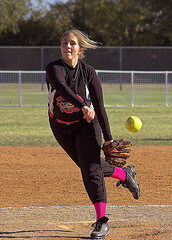Pitching at any level is a test of endurance, confidence and, most importantly, preparation. Many of today’s young pitchers do not understand that proper preparation involves repetition and drills that can sometimes be boring and mundane. In the long run, these same “boring and mundane” drills can make the difference between being able to pitch a perfect game and just being able to make the starting line-up.

I have received many questions about pitching from pitchers, coaches and players, but none more frequently than “What drills can I do to improve my pitcher/pitching?” Here are a few of the more effective drills.Wrist Snaps: Wrist snaps are responsible for the type and quickness of spin (rotation of ball). They are often over looked as unimportant and minor. How many times should the ball spin for 40 feet? 40 times? 50 times? On a good day, the ball will spin no more than five times. Neglecting wrist snaps and spins will reduce the number to 2 – 3 times, resulting in weaker movement.Knee Drill: The knee drill restricts the use of the lower body, concentrating on hand rotation, arm circle, wrist snaps, release point and follow through. A right-handed pitcher puts their right knee on the ground and their left knee at a 90 degree angle in front of her body.When the pitching motion begins, it is important to keep the arm flowing in a complete circle, staying close to the ear and close to the hip. As the pitching arm begins its circle, the glove arm also moves up at approximately a 90 degree angle, snapping down during the pitcher’s downswing. Upon releasing the ball (at 6 o’clock if the arm circle represents a clock), the arm should follow through with the elbow facing the catcher.
L-Drill (also called the X-Drill): The L-Drill eliminates the first half of a pitcher’s windmill motion, focusing on arm speed, arm and leg follow-through, and body timing. It starts the hurler with her hips “open”, glove arm pointed at the target, and pitching arm almost straight up beside the ear. (The wrist is cocked with the ball facing the sky.) The pitching arm and glove arm begin to swing downward. As soon as the pitching arm passes the hip, the leg and hip explode shut.
Walking Drill: The walking drill is designed to show new pitchers that the pitching motion is not only natural, but must be done in a relaxed and fluid manner. The pitcher begins to walk normally. After 5 to 10 steps, she must take the ball out of her glove and pitch it while continuing to walk.Wall Drill: The Wall Drill is typically used as a corrective tool when a pitcher is bending with her upper body, having difficulty with her stride, or having a problem keeping her arm close to her body during the pitching circle. Standing three feet away from the wall (pitching arm closest to wall), the pitcher will simulate her motion. The proximity to the wall will help prevent bending and will correct an arm circle that strays too far from her body.